

For several years, the GDCh has been awarding the "Theme Prize for the Linking of Theory with Chemical Practice" as part of the "Jugend forscht" competition.
The GDCh uses this award to recognize outstanding experimental work in chemistry with a sound theoretical justification or derivation. The prize is worth 1,000 euros and, like all special prizes, is traditionally awarded on the evening before the awards ceremony for the national competition.
The prize, like the GDCh Abitur Prize, underlines the GDCh's aim of encouraging young people to explore and understand our world scientifically.
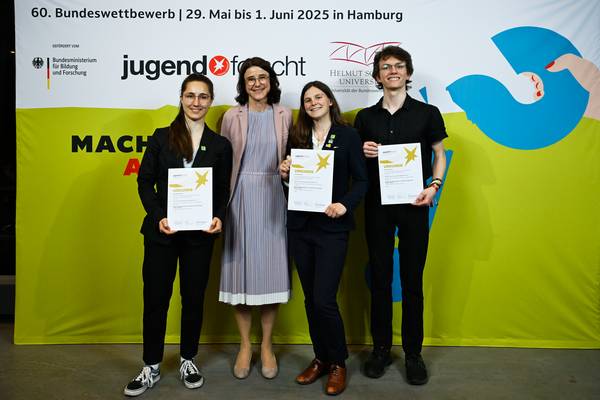
Anne Marie Bobes (18), Dresden University of Technology, Alina Bachmann (21), Goethe University Frankfurt, and Alois Bachmann (18), Humboldt-Gymnasium Berlin-Tegel
Calculate atoms easily: SpectralAI – Determination of atomic spectral lines with AI
The properties of an atom are determined by the energy levels of its electrons. These levels can be visualized through complex measurements of spectral lines.
Anne Marie Bobes, Alina Bachmann, and Alois Bachmann circumvented the complex measurement procedure and had artificial intelligence (AI) calculate the spectral lines. They trained their AI model with atomic properties and some known spectral lines from databases. This enabled the AI to predict the spectral lines of all chemical elements.
For comparison, the young researchers determined the energy levels of some atoms in the laboratory and compared them with the computational results. The AI's accuracy was high at more than 90 percent. Furthermore, the model also predicted new, previously unknown spectral lines of chemical elements.
The winning team will receive prize money of 1,000 euros and a one-year free membership in the GDCh for each team member.
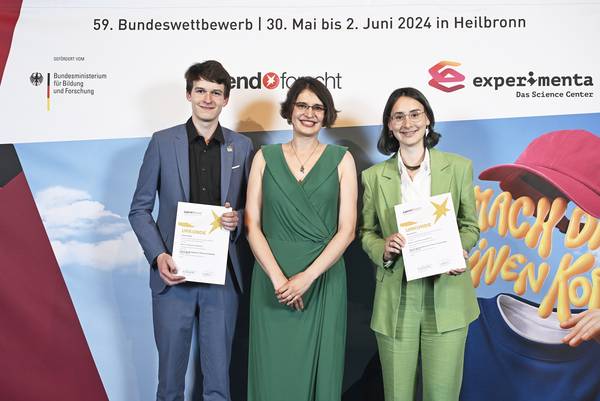
Nicholas Dahlke (17) and Anna Perkovic (17), Hans-Thoma-Gymnasium, Lörrach, and phænovum Student Research Center Lörrach-Dreiländereck
Unsolved chemistry puzzle: Mpæmba – hypothermia with memory?
The so-called Mpemba effect states that hot water freezes faster than cold water. To get to the bottom of this mystery, Nicholas Dahlke and Anna Perkovic investigated the crystallization of hot and cold water using a self-constructed apparatus. The core of the device is a very thin tube through which synthetic oil and ultrapure water were pumped. Tiny water droplets formed in the oil, which were suddenly cooled to minus 33 degrees Celsius. The young researchers observed that the different water temperatures lead to different nucleation rates, i.e., the amount of crystal nuclei that are formed. With their experiments, they were able to reproduce and precisely measure the Mpemba effect, but the mystery of the effect remains unsolved.
The winning team will receive prize money of 1,000 euros and a one-year free membership in the GDCh for each team member.
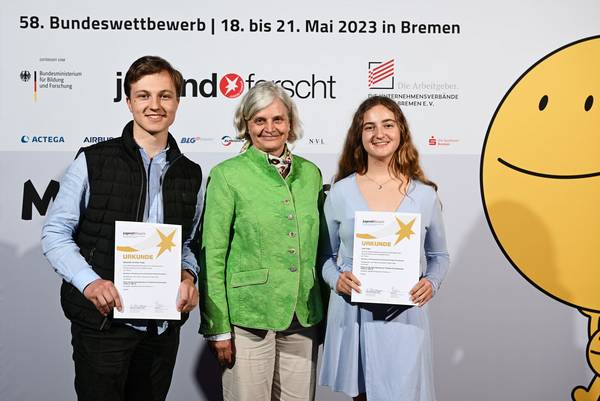
Julia Trapp (15), Grafrath, Ernst-Reisinger-Gymnasium, Schondorf am Ammersee, and Alexander Christian Trapp (18), Grafrath, Julius-Lohmann-Gymnasium, Schondorf am Ammersee
Bio-Power: Development of a biochemical redox flow battery
Redox flow batteries are powerful energy storage devices and are well suited as a reservoir for electricity from wind turbines and solar systems in times of climate change. However, in order to achieve the highest possible energy density, toxic inorganic vanadium salts are mostly used. Julia Trapp and Alexander Christian Trapp set themselves the goal of building an environmentally friendly redox flow battery. To do this, they developed a battery cell of a similar design in which yeast and methylene blue are used. The cell voltage reached a good 0.6 volts, and the charging capacity was around 2.6 ampere hours per liter of methylene blue solution. But that is just the beginning: the young researchers are thinking about using waste materials from the food industry in a similarly constructed electricity storage device in the future.
The winning team can look forward to prize money of 1,000 euros and a one-year free membership in the GDCh for each team member. The team also achieved second place in the national competition in the chemistry category.
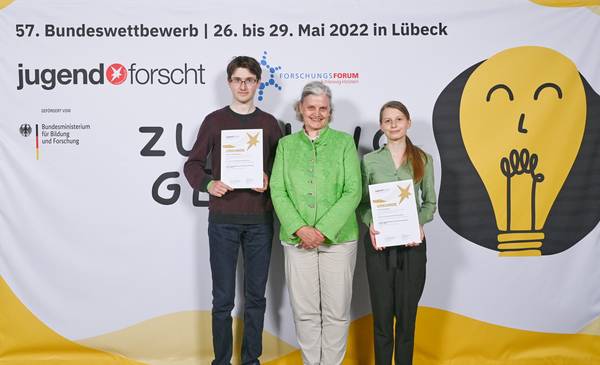
Anna-Yaroslava Bodnar (17), Alexander Csaba Baumgarten (18), Heinrich-Hertz-Gymnasium, Berlin
On the trail of aluminum – development of semi-quantitative metal ion indicators
Certain organic molecules form colored complexes with metal ions and are therefore well suited to detecting metal contamination in the environment. Anna-Yaroslava Bodnar and Alexander Csaba Baumgarten developed a test solution for the analysis of aluminum. They mixed three chemically similar complexing agents to detect high and low aluminum concentrations. Using a computer program, the two simulated the mixing ratio with the best color separation and the resulting colors. Their photometric measurements in the laboratory confirmed the calculated recipe and the equilibrium model that describes the attraction of the dye molecules to the aluminum ions. If the selection of molecules is changed, tests for other metals could also be simulated.
The award-winning team already received the GDCh award in 2021. This year they also won 3rd prize in the chemistry category.
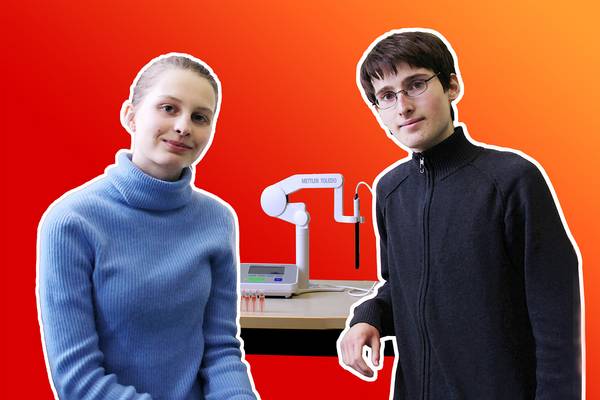
Anna-Yaroslava Bodnar (16), Alexander Csaba Baumgarten (17), Heinrich Hertz High School, Berlin
Aluminum in dinner? ? Indicator for the quantitative analysis of aluminum ions
Aluminum is suspected of being harmful to human health. Anna-Yaroslava Bodnar and Alexander Csaba Baumgarten have long been concerned with the question of how to quickly and easily determine the aluminum content in food. To do this, they used dyes that form molecular complexes with aluminum ions. Mixing and testing the dyes in an optimal ratio proved to be tricky, as laboratory tests were not possible due to the corona pandemic. The young researchers therefore moved the laboratory to their home office: they used the computer to calculate the spectra of the various molecular complexes and dye mixtures. Based on these formulas, the two believe, easy-to-use test sticks for the home can be developed.
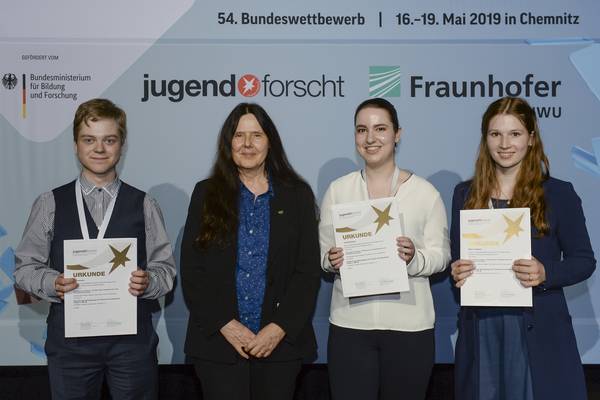
Milena Wiegand (18), Erfurt, Max Asenow (18), Bad Berka, and Tina Munkewitz (18), Eisenach
Albert Schweitzer High School Erfurt, Institute for Organic Chemistry, Friedrich Schiller University Jena
Highlighter for proteins - synthesis of new thiazole derivatives for fluorescence microscopy
With the help of fluorescent dyes, vital proteins in cells can be marked and their metabolism made visible. The winners synthesized two new fluorescent dyes - Matao blue I and Matao blue II. They used these to stain bacteria, cancer cells and plant samples. Under the fluorescence microscope, they could see that different proteins were marked in blue in the different cell types: in bacteria, the dyes accumulated at the cell poles, in cancer cells in the area around the nucleus. For the complex evaluation of the analysis data, the young researchers developed software with which the data can be processed more quickly and easily.
The jury was particularly impressed that Milena Wiegand, Max Asenow and Tina Munkewitz not only developed their own interesting problem, but also recognized the potential of the new dyes in the course of their research. Everyone in the team contributed their strengths, so that the young researchers achieved an excellent overall result in a particularly interdisciplinary manner.
For her work, she was not only awarded the GDCh special prize but also the prize for the best interdisciplinary work from the Federal Minister for Education and Research, Anja Karliczek, Member of the Bundestag.
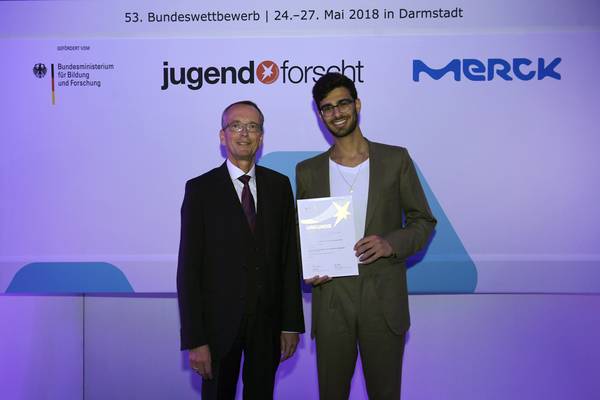
Malek Sbeih (19), Weimar
Carl Zeiss Gymnasium Jena, Friedrich Schiller University Jena
Fat dissolver with light switch: synthesis and investigation of photochemically switchable surfactants
Surfactants clean so effectively because, thanks to their bipolar structure, they firmly lock in fat and oil particles and separate them from the water. Malek Sbeih went in search of surfactants whose function can be controlled and which can be recycled. He came across spiropyrans - molecules that change when exposed to light. The young researcher coupled spiropyrans with organic acids and thus obtained light-switchable surfactants: Under UV light, the fat dissolvers form spherical micelles around oil and fat, which can be filtered off. When irradiated with green light, on the other hand, the micelles disintegrate and the surfactants are released again. In the opinion of the young researcher, a new method could be developed on this basis that could be used to purify sea and river water, especially in the event of oil spills.
The young researcher convinced the jury with his creativity and well-founded specialist knowledge. With his project he demonstrated a high degree of independence and determination. His written work as well as his presentation showed a high scientific level.
For his work, he was not only awarded the GDCh special prize but also first prize in the chemistry category and the prize of the federal sponsorship company (Merck), a research stay in Great Britain.
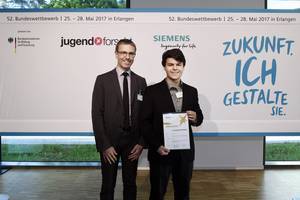
Arta Safari (17),
Altes Gymnasium, Bremen, and Hybrid Materials Interfaces Group, University of Bremen Strong forces in thin layers: Immobilization of laccase for catalytic applications Certain enzymes form layers on surfaces that are only one molecular layer thick. Arta Safari suspects that such monolayers could be used to develop highly effective catalysts. However, it has not yet been clarified which forces are involved in the attachment. The young researcher simulated the interactions of the enzyme laccase with surfaces made of both silicon dioxide and graphene, a special form of carbon, on the computer. He found that laccase is retained on silicon dioxide by electrostatic interactions. In the case of graphene, on the other hand, the charge clouds of enzyme building blocks and carbon overlap. Since this bond is particularly strong and independent of external factors, graphene would be ideal as a carrier for biocatalysts. For his work, he was not only awarded the GDCh special prize but also third prize in the chemistry category.
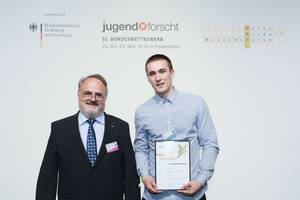
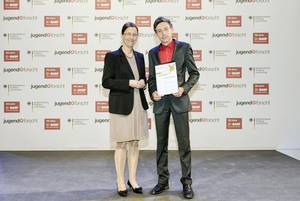
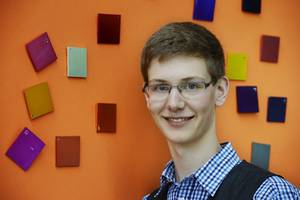
"Supramolecular host-guest complexes as fluorescence markers in tumor diagnosis and therapy"
As part of his project, the eighteen-year-old Salg succeeded in demonstrating the link between theory and chemical practice in an outstanding manner.
Salg has found a way how the luminosity of fluorescent dyes can be increased. To do this, he used host-guest complexes that have not yet been researched for this application. The award winner provides an explanation of how this works here.
The work was carried out by Dr. Roland Full, teacher at the Hanns-Seidel-Gymnasium in Hösbach, is in charge. Long-time GDCh member Full has already supported several participants in the competition in the past few rounds and accompanied national winners and winners of various special prizes. Fulls exemplary commitment drew the German Chemical Society, 1996, Heinrich Roessler Prize of the division for Chemical Education.
"Reaction Paths of Ferrocene and Troticen" As part of his project, the sixteen-year-old Spors succeeded in demonstrating the link between theory and chemical practice in an outstanding way. Dominik Spor's favorite subject has always been chemistry. He is particularly fascinated by reactions in which organic and inorganic chemistry meet, for example in organometallic complexes. Some of them show the typical behavior of aromatics such as benzene, but at the same time, due to the central metal atom, also properties such as so-called diamagnetism. Using ferrocene and troticen as an example, the young chemist investigated how complexes react with other metal-containing or organic compounds and analyzed the products with the help of mass spectroscopy. He found that the two chemically similar compounds differ unexpectedly in their reactivity. (c) Jugend forscht e. V.
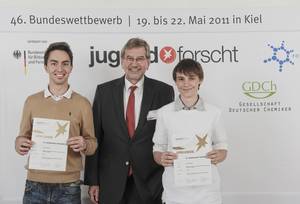
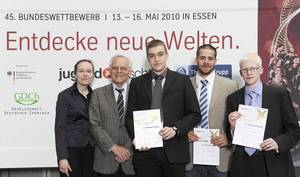
"Why does iron sulfide synthesis whistle?" As part of their project, Ali Karaca, Björn Bankowski and Daniel Lamonski succeeded in presenting the link between theory and chemical practice in an outstanding way.
?If you put sulfur powder and iron wool in a test tube and heat the sulfur, you may hear a whistling sound. We wanted to deal with this phenomenon. In all relevant textbooks one can read that the clay is created due to the strongly exothermic reaction. We were critical of this statement and wanted to know the real reason for this phenomenon. To do this, we proceeded step-by-step: First, we succeeded in generating a reproducible sound by optimizing the initial experiment. Then we examined how the tone was influenced by changing individual parameters (iron wool: length and structure, test tube volume, test tube opening).
The result of this series of tests was that the audio frequency changes due to the parameters mentioned. We also found that the test tube is the sound box of the sound. By preventing the chemical reaction between sulfur and iron, we were able to show that a whistling sound is also produced here and thus the reaction is not the reason for the sound being produced.
Based on these results, we developed the following theory: The rising sulfur gas stream is broken at the iron wool fibers and thus causes pressure fluctuations in the test tube, which ultimately generate vibrations that can be heard as sound. This corresponds to the principle of sound development in a recorder.
In further experiments we found that the clay can also be produced without the use of sulfur. From this we concluded that this is a physical phenomenon, the thermoacoustic effect. This is based on the thermodynamic cycle in which the air is made to vibrate due to temperature differences above and below the iron wool. ?(C) Nachrichten aus der Chemie
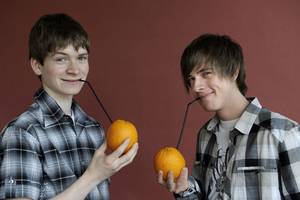
"The focus of our work was the vitamin C stress in the kitchen," said Timo and Thomas. And so they demonstrated, among other things, that in an aqueous solution the loss of vitamins after standing for four hours was already over 10 percent and that vigorous stirring (oxygen exposure) and heat are particularly effective vitamin C killers. The losses were enormous, especially when heating in a pressure cooker. The addition of cyclodextrin, a permitted food additive, was able to reduce losses by over 80 percent at higher temperatures. The students not only analyzed the vitamin C content, but also the spatial structure of the host-guest relationship between cyclodextrin and vitamin C. They also called the topic of their work ?News from the molecular kitchen: Cyclodextrin protects vitamin C?. And they also had products from their molecular cuisine on offer at the national competition from May 21 to 24 in Osnabrück: self-pressed orange juice, pasteurized kiwi juice and jams made from mango and kiwi.
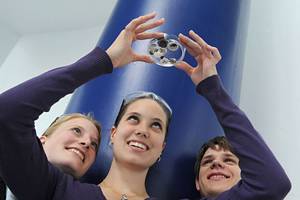
"Synthesis of Opals" For the first time since 2003, the German Chemical Society (GDCh) has again awarded a special prize at this year's 43rd national competition "Jugend forscht". The award was given to a work in chemistry that particularly successfully combined theory and practice. The winning team, Felix Brunner, Raphaela Baumann and Johanna Kaltenbach from the Georg Kerschensteiner School in Müllheim (district of Breisgau-Hochschwarzwald) received the special prize of 1,000 euros for the successful synthesis of opals using simple means. "I was impressed that this team of students has succeeded in producing artificial opals with the simple means available to a school, solely on the basis of very good theoretical knowledge of Materials Science and intelligently carried out experiments," said the former GDCh president with admiration Professor Dr. Henning Hopf after the award ceremony on May 24th. This is a nice practical example from chemistry with everyday relevance, which almost has a craft character. Overall, Hopf was very pleased with the high level of the presentations at the national ?Jugend forscht? competition, which took place in Bremerhaven from May 22nd to 25th.
From 2004 to 2007, the GDCh special award for Jugend forscht was not awarded, as it was initially only intended as a one-off event for the 2003 Year of Chemistry. In the years that followed, the GDCh became more and more involved in promoting young people, so that the special award was resumed in 2008 and has been awarded annually since then.
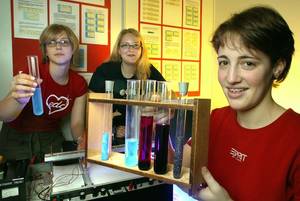
"Diffusion speed in aqueous solution" Anyone who drinks their coffee with milk is familiar with the phenomenon that Julia Drehmer, Angela Marx and Kathrin Brandt dealt with. Without the influence of external forces, coffee and milk mix to form a homogeneous liquid. This so-called diffusion is caused by the independent and disordered movement of ions, atoms and molecules. The students were interested in whether the mixing takes place at a certain, unchangeable speed. To do this, they investigated the diffusion path of permanganate ions and copper (II) ions at different time intervals. Result: The diffusion speed depends on the type of ions and their concentration. The place and time of the mixing process also play a role. (c) Jugend forscht e. V.
This page has been machine translated. If you have any feedback or comments please feel free to contact us. 
last modified: 02.06.2025 10:29 H from N/A